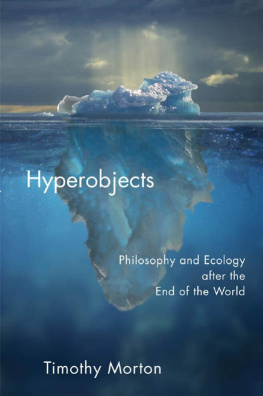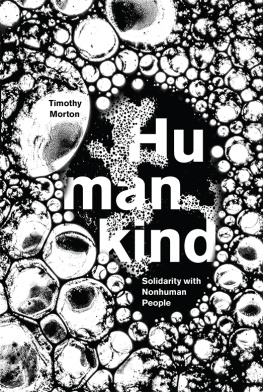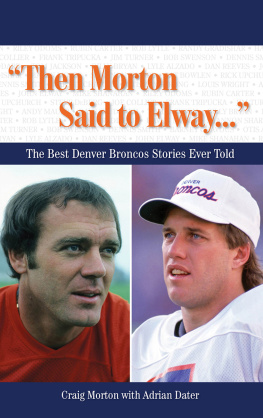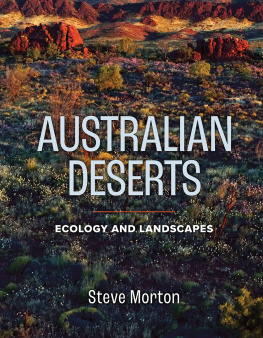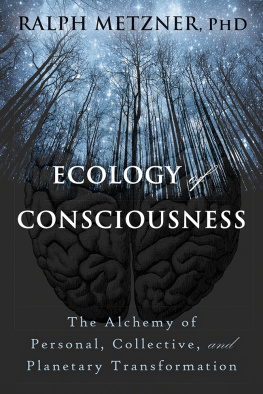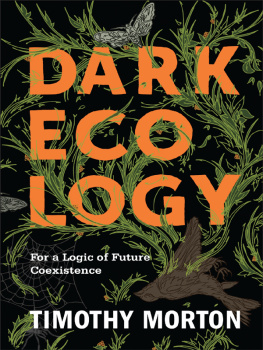Timothy Morton - Hyperobjects: Philosophy and Ecology after the End of the World
Here you can read online Timothy Morton - Hyperobjects: Philosophy and Ecology after the End of the World full text of the book (entire story) in english for free. Download pdf and epub, get meaning, cover and reviews about this ebook. year: 0, genre: Science. Description of the work, (preface) as well as reviews are available. Best literature library LitArk.com created for fans of good reading and offers a wide selection of genres:
Romance novel
Science fiction
Adventure
Detective
Science
History
Home and family
Prose
Art
Politics
Computer
Non-fiction
Religion
Business
Children
Humor
Choose a favorite category and find really read worthwhile books. Enjoy immersion in the world of imagination, feel the emotions of the characters or learn something new for yourself, make an fascinating discovery.
- Book:Hyperobjects: Philosophy and Ecology after the End of the World
- Author:
- Genre:
- Year:0
- Rating:5 / 5
- Favourites:Add to favourites
- Your mark:
- 100
- 1
- 2
- 3
- 4
- 5
Hyperobjects: Philosophy and Ecology after the End of the World: summary, description and annotation
We offer to read an annotation, description, summary or preface (depends on what the author of the book "Hyperobjects: Philosophy and Ecology after the End of the World" wrote himself). If you haven't found the necessary information about the book — write in the comments, we will try to find it.
Hyperobjects: Philosophy and Ecology after the End of the World — read online for free the complete book (whole text) full work
Below is the text of the book, divided by pages. System saving the place of the last page read, allows you to conveniently read the book "Hyperobjects: Philosophy and Ecology after the End of the World" online for free, without having to search again every time where you left off. Put a bookmark, and you can go to the page where you finished reading at any time.
Font size:
Interval:
Bookmark:

Philosophy and Ecology after the End of the World
Timothy Morton
U n i v e r si t y o f M i n n e s ota Pre s s M i n n e a p o l i s L o n d o n
The University of Minnesota Press gratefully acknowledges financial assistance provided for the publication of this book by Rice University.
Midnight Oil by Sheryl St. Germain reprinted by permission of the poet. Portions of A House Is a House for Me by Mary Ann Hoberman, copyright 1978 by Mary Ann Hoberman, reprinted by permission of Viking Penguin, a division of Penguin Group (USA) Inc. Styrofoam Cup by Brenda Hillman reprinted by permission of the poet.
Copyright 2013 by Timothy Morton All rights reserved. No part of this publication may be reproduced, stored in a retrieval system, or transmitted, in any form or by any means, electronic, mechanical, photocopying, recording, or otherwise, without the prior written permission of the publisher.
Published by the University of Minnesota Press 111 Third Avenue South, Suite 290
Minneapolis, MN 55401-2520
http://www.upress.umn.edu
A Cataloging-in-Publication record for this book is available from the Library of Congress.
ISBN 978-0-8166-8922-4 (hc) ISBN 978-0-8166-8923-1 (pb) Printed in the United States of America on acid-free paper The University of Minnesota is an equal-opportunity educator and employer.
20 19 18 17 16 15 14 13 10 9 8 7 6 5 4 3 2 1
To my extended families
I am become death, the shatterer of worlds.
Robert Oppenheimer, after the Bhagavad Gita
Cary Wolfe (the Posthumanities series editor) and Douglas Armato (the director of the University of Minnesota Press) deserve deep thanks for their support of this project, as does Steven Shaviro, whose kind reading of the book was both helpful and inspiring. Associate editor Danielle Kasprzak ably saw the book through production. Thanks also to Nicolas Shumway, dean of the School of Humanities at Rice University, for research fund assistance.
I was very lucky to have been able to road test many of the ideas here in a number of fora: the California Institute of the Arts; the Second Object-Oriented Ontology Symposium, UCLA; the Architectural Association, London; the National Institute for Experimental Arts, Sydney; the University of Melbourne Law School; Dialogues with Tomorrow, New Zealand; Tunghai University and National Chung-Hsing University, Taiwan; the Rocky Mountain Modern Language Association, Albuquerque; Loyola University, New Orleans; Rice University; Rutgers University; the Georgia Institute of Technology; the Design and Sustainability Symposium at the New School, New York; Temple University; the Department of Philosophy at De Paul University ; the Royal College of Art, London; Columbia College, Chicago; the Royal Academy of Art, London; the Climate Change and Critical Theory Conference at the University of Exeter; and the Emergent Environments Conference, Queen Mary University of London. A number of journals have also helped me to crystallize my thoughts: Qui Parle, Speculations, World Picture, Adbusters, Graz Architectural Magazine, English Language Notes, Helvete, and Romantic CirclesPraxis. The websites Fractured Politics and Figure/Ground interviewed me on hyperobjects and the Contemporary Condition solicited a short essay on the subject.
To my colleagues in object-oriented ontology I am profoundly grateful for the chance to share the exciting work of thinking. I am very grateful to Dirk Felleman, who over the last two years has been an invaluable source of feedback and information, thinking things through alongside me. Thanks to Larry Butz and Ben Levaton, who provided invaluable research assistance. I am thankful to all my kind hosts and colleagues over these last two years for helping me to think hyperobjects: Jane Bennett, Jill Bennett, Hannes Bergthaller, Steven Blevins, Eliza Bonham-Carter, Alan Braddock, Kuei-fen Chiu, William Connolly, Arne DeBoever, Carl Douglas, Rick Elmore, Paul Ennis, Jarrod Fowler, William Fox, Nathan Gale, Peter Gratton, Jairus Grove, Liam Heneghan, Robert Jackson, Sophie Jerram, Adeline Johns-Putra, Douglas Kahn, Michelle Leh, Kevin Love, Dugal MacKinnon, Jorge Marcone, Lin Mu, Judy Natal, Connal Parsley Alexander Regier, David Reid, Ken Reinhard, Julia Reinhard Lupton, Gerhard Richter, Chris Schaberg, Janelle Schwartz, Sam Solnick, Cameron Tonkinwise, Hent Vinckier, Jonathan Watts, and Andrew Whatley.
This book is dedicated to my extended families. Hyperobjects make you think about how families are fuzzy sets of beings, distributed over spaces and times wider than me and my immediate surroundings.
In The Ecological Thought I coined the term hyperobjects to refer to things that are massively distributed in time and space relative to humans. A hyperobject could be a black hole. A hyperobject could be the Lago Agrio oil field in Ecuador, or the Florida Everglades. A hyperobject could be the biosphere, or the Solar System. A hyperobject could be the sum total of all the nuclear materials on Earth; or just the plutonium, or the uranium. A hyperobject could be the very long-lasting product of direct human manufacture, such as Styrofoam or plastic bags, or the sum of all the whirring machinery of capitalism. Hyperobjects, then, are hyper in relation to some other entity, whether they are directly manufactured by humans or not.
Hyperobjects have numerous properties in common. They are viscous, which means that they stick to beings that are involved with them. They are nonlocal; in other words, any local manifestation of a hyperobject is not directly the hyperobject. They involve profoundly different temporalities than the human-scale ones we are used to. In particular, some very large hyperobjects, such as planets, have genuinely Gaussian temporality: they generate spacetime vortices, due to general relativity. Hyperobjects occupy a high-dimensional phase space that results in their being invisible to humans for stretches of time. And they exhibit their effects interobjectively; that is, they can be detected in a space that consists of interrelationships between aesthetic properties of objects. The hyperobject is not a function of our knowledge: its hyper relative to worms, lemons, and ultraviolet rays, as well as humans.
Hyperobjects have already had a significant impact on human social and psychic space. Hyperobjects are directly responsible for what I call the end of the world, rendering both denialism and apocalyptic environmentalism obsolete. Hyperobjects have already ushered in a new human phase of hypocrisy, weakness, and lameness: these terms have a very specific resonance in this study, and I shall explore them in depth. Hypocrisy results from the conditions of the impossibility of a metalanguage (and as I shall explain, we are now freshly aware of these conditions because of the ecological emergency); weakness from the gap between phenomenon and thing, which the hyperobject makes disturbingly visible; and lameness from the fact that all entities are fragile (as a condition of possibility for their existence), and hyperobjects make this fragility conspic-uous. Hyperobjects are also changing human art and experience (the aesthetic dimension). We are now in what I call the Age of Asymmetry.
Hyperobjects are not just collections, systems, or assemblages of other objects. They are objects in their own right, objects in a special sense that I shall elucidate as we proceed through this book. The special sense of
Next pageFont size:
Interval:
Bookmark:
Similar books «Hyperobjects: Philosophy and Ecology after the End of the World»
Look at similar books to Hyperobjects: Philosophy and Ecology after the End of the World. We have selected literature similar in name and meaning in the hope of providing readers with more options to find new, interesting, not yet read works.
Discussion, reviews of the book Hyperobjects: Philosophy and Ecology after the End of the World and just readers' own opinions. Leave your comments, write what you think about the work, its meaning or the main characters. Specify what exactly you liked and what you didn't like, and why you think so.

